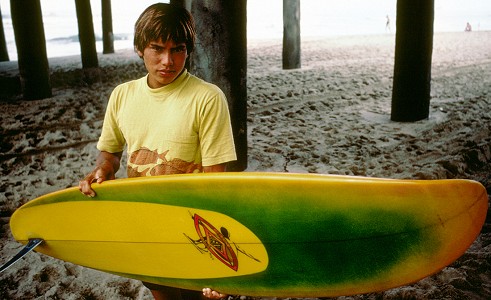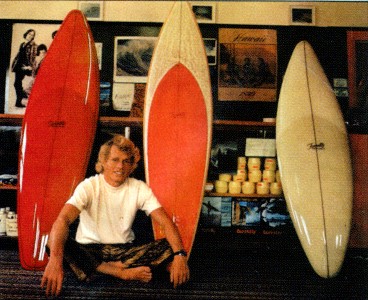 |
surfresearch.com.au
the catalogue #212 |
| home | catalogue | history | references | appendix |
|
|
|||||||||||||||||||||||||||||||||||||||||||||||||
 |
|||||||||||||||||||||||||||||||||||||||||||||||||
| MANUFACTURE
MANUFACTURER: Odin Surfboards, Ballina NSW SHAPER: Rick Purnell DESIGN: Side Slipper DESIGNER: Reno Abellira Australia : Midget Farrelly - Terry Fitzgerald |
|||||||||||||||||||||||||||||||||||||||||||||||||
| SPECIFICATIONS
CONSTRUCTION Foam blank with resin glue line stinger, Volan glass with purple tint, resin pinlines, marble deck patch decor, fin recessed into blank. DIMENSIONS
Nose: rounded Tail: rounded square Deck: S-deck, domed Bottom: flat , vee behind fin. Rails: 50/50 in nose and soft down rail from 1/3 rd back, harder in the tail. Rocker: distinct nose lift |
|||||||||||||||||||||||||||||||||||||||||||||||||
|
|||||||||||||||||||||||||||||||||||||||||||||||||
|
|||||||||||||||||||||||||||||||||||||||||||||||||
| NOTES
BOARD HISTORY Purchased Nowra Tip, 2000? Cleaned and photographed. Sanding to remove poor quality repairs and the Plasti-bond filled tail. MANUFACTURER HISTORY Odin Surfboards which I started up in Ballina around 1969 , after leaving Maroubra. -Rick Purnell, July 2005. Rick offered more information on Odin Surfboards and I emailed that I would complete this entry and contact him for further details. Unfortunately I have lost the email address, apologies to Rick. Brian Cronshaw forwarded the following details in December 2017: Manager: Rick Purnell Shaper: Peter Dutton (Queensland) Glasser: Barry Pussell (Maroubra) And From memory Peter was the driving force behind the Odin name and graphics. The Side Slip (Fin Drop Out Stall) was first identified in 1967 by Bob McTavish in an article titled... bob mctavish is in this wave. he probably had a plan to get out of it, (Surfing World Magazine January 1967 Pages 15 to 21). A compendium of (long board) manouvres , it includes... FIN
DROP-OUT
STALL
IMPORTANT
: Not
to be confused with "slipping the board " - a nose
riding manoeuvre that
does not disengage the fin.
SIDE SLIPS can
be performed
anywhere on the front half of the board.
Side
slipping became
an recognised manourve in 1969, as demontrated
in John Severson's
Pacific Vibrations, 1970.

Reno Abellira and Inter-Island Side Slipper with hyper-kicked nose, Huntington Pier, California, 1969. Photograph Art Brewer Nat Young : History, Page 104 To initiate the side slip the fin had to be dis-engaged, so the design critically relied of using smaller and inter-changable fins. Fin boxes were virtually a required addition. This demand encouraged research into fin boxes and by 1972 the Bahne system became an industry standard. A flat
bottom with
a down soft rail that reduced the possiblility of
catching edges was used
to control the side-slip and re-engage the fin
A
hyperkicked nose
reduced the chance of burying the nose and helped in
recovery.
In Australia the down soft rail, with a release edge, was developed through the experiments of Gordon Merchant. (Find relevant articles) In Australia the design was taken up by Midget Farrelly (Farrelly Surfboards) and Terry Fitzgerald at Shane Surfboards. 
 The only board that allows the surfer to ride sideways, backwards or in a spinning circle. The slipper has advantages a conventional board lacks Speed comes easy, control is super positive through the flat bottom and low, soft rails. Basically, the board is longer, thinner and a diamond shape in outline. The fin is smaller to facilitate release only when desired. The rails amd bottom allow a shallow draft fin in any case, and the fin used is both adjustable and removable. Midget has ridden this shape in most every kind of wave. Reef surf was where the speed from the bottom and the rails was best put to use. In beach break the board responded to all manouvres and created new freedoms with side slips to hold curl position and 360's to fill the gap between peaks of sections. Fantastic sensations can be had riding whole sections backwards. The most average surfer is going to find this surfboard easy to ride. Thje side slipper can't be compared to any other board that has gone before it. The only limitation this surfboard has is the surfer who rides it. Farrelly Surfboards, 230 Harbord Road, Brookvale 2018 Phone : 939-1724. Above quoted text and images and text from... Farrelly Surfboards Advertisment, circa 1969. Re-printed in Walding, page 76. Note : - The red board on the left has a much wider tail than the two to the right. - Volan deck patches. Although Reno Abellira and Midget Farrelly rode Side Slipper designs, there are no contest photographs of them (or others) side slipping. The situation is similar in Paul Witzig's Sea of Joy, 1971. Due to the lack of suitable wave conditions, the required high skill level, the potential for confusion in crowed conditions and/or the rejection by contest officials: side slipping receeded dramatically. While
the Side Slipper
appeared to be a minor deviation, it did have
major design influence...
The
manouvre, despite
all predictions, would re-appear in the late 1980's
initially as the Floater,
credited to Mark Sainsbury.
Due to
the ten year
gap, the connection between side slipping in the 1969
and the 1980's was,
understandably, largely ignored by commentators.
CONDITION: 5 |
|||||||||||||||||||||||||||||||||||||||||||||||||

 |
|||||||||||||||||||||||||||||||||||||||||||||||||

surfresearch.com.au |
| home | catalogue | history | references | appendix |